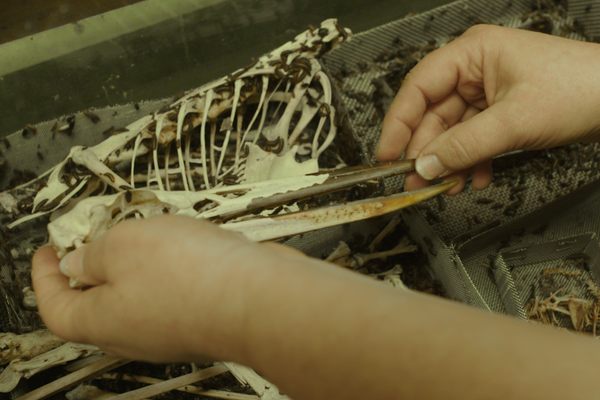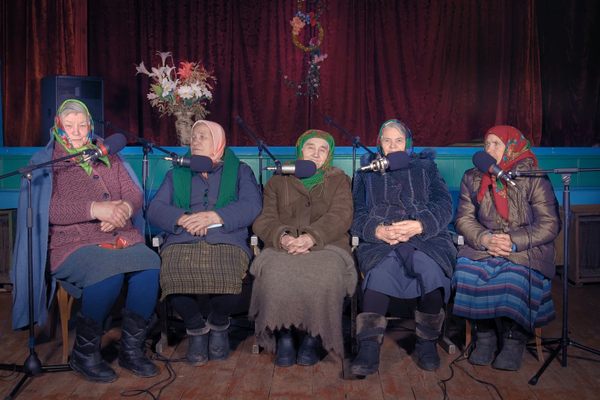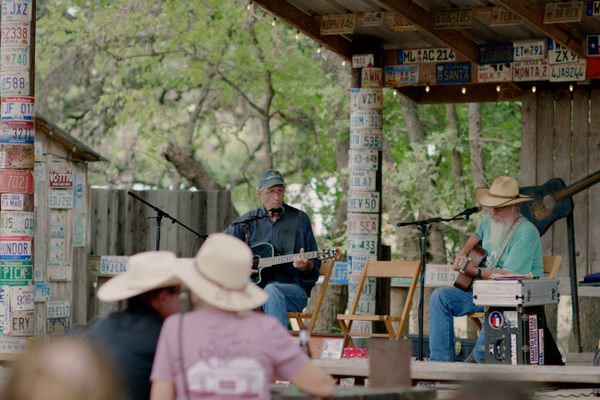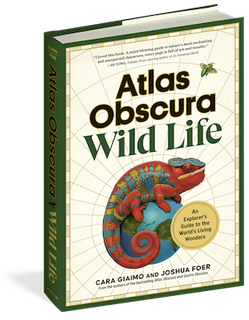Did Lyrebirds Steal These Songs From Humans?
Australian lyrebirds can imitate car horns, chainsaws … and beautiful flute music.
Listen and subscribe on Apple Podcasts, Spotify, and all major podcast apps.
Elah Feder: A few weeks ago, I contacted someone named Judith Finell, not really expecting to hear back from her, because Judith is a forensic musicologist, and she’s in very high demand. On a typical day, she’s advising companies like Disney and Netflix to help them avoid copyright infringement, or she’s sharing her expertise in high-profile legal cases. Remember when Robin Thicke and Pharrell Williams were sued for copying parts of “Blurred Lines”? That was Judith. She was the expert witness that helped clinch the case against them and for Marvin Gaye’s estate. So I really didn’t think that Judith would have any time for my case, but I sent her an email, and she wrote back right away.
Judith Finell: I’m glad you found me, it really gave me a lot to think about, just preparing for this, so thank you.
Elah: Wait, what did it give you to think about? I mean, I feel like you’re dealing with music plagiarism day in, day out.
Judith: I am. I am. From humans.
Elah: That’s right. The case I laid before Judith was both strictly pro bono, and it was against birds. On the east coast of Australia, high up in dense forests of eucalyptus and southern beech trees, there’s a group of birds that appear to have swapped out their usual songs for something more melodic. It’s the only place in the country where these birds are known to sing like this. And it might get them in some trouble, because allegedly, they got these songs from us. I’m Elah Feder, and this is Atlas Obscura, a celebration of the world’s strange, incredible, and wondrous places. Today, lyrebirds in Australia stand accused of copying human music. Specifically, two songs they learned in the 1920s. It’s a story that’s been repeated a few times on the internet as just a fun fact. But is it a fact? A small team set out to investigate.
Hollis Taylor: And along the years of our study, at any one point, I think it’s fair to say that all four of us believed it. And then all four of us maybe had serious doubts about it.
Elah: And I bring Judith Finnell, a case that’s finally worthy of her talents.
Judith: It’s really interesting. Yeah, I mean, it’s sort of surreal that this is even coming up.
This is an edited transcript of the Atlas Obscura Podcast: a celebration of the world’s strange, incredible, and wondrous places. Find the show on Apple Podcasts, Spotify, and all major podcast apps.

Hollis: So, shall we say the story?
Elah: Yeah, that’d be great. Hollis Taylor is a violinist, composer, and zoomusicologist living in Australia. And about 15 years ago, she and three friends decided to get to the bottom of this lyrebird story. The lyrebirds in question are these superb lyrebirds, living in forests in and around the New England Tablelands, which is near the coast of New South Wales.
Hollis: Okay, so as the story goes, a lyrebird chick was raised in captivity in the 1920s. He mimicked the household’s flute player, and he learned, allegedly, two tunes and an ascending scale. And then released back into the wild, his flute-like songs were picked up by the other local lyrebirds.
Elah: Generations later, lyrebirds in the area are still singing these old songs, kind of like a living time capsule in the forest. The idea that lyrebirds do this is totally plausible. It’s almost unremarkable if you’ve heard anything about what they’re capable of. Lyrebirds are songbirds, big brown ones that look kind of like pheasants. When male lyrebirds fan out their tails, you see these two long brown feathers on either side and a mess of stringy white feathers in the middle, so that if you squint, the whole thing kind of looks like a lyre, the ancient instrument. When a male lyrebird is trying to seduce a female, he clears out a little area on the ground, makes a kind of performance stage for himself, where he puts on this astoundingly complicated song and dance.
Now, I’ve watched a bunch of videos of this, and it is the most bizarre, goofy display you can imagine. There’s wiggling, there’s chirping, and in at least one video I watched, what I can only describe as the sound of space lasers. And I would love to play it for you here, but in the course of reporting this episode, I’ve become acutely aware of copyright issues. So instead, please enjoy this equally incredible lyrebird, recorded by someone named Marc Anderson, and shared under a Creative Commons license on xeno-canto.org. The songs of the lyrebird are worth talking about in their own right, but peppered throughout each bird’s routine is the thing that makes these birds famous: mimicked sounds.
Hollis: They will imitate other bird calls and songs, they’ll imitate bird wings, and they will even imitate anthropogenic noise.
Elah: And these birds are so good at mimicry. David Attenborough, he once featured a captive lyrebird who could perfectly recreate the sound of a camera shutter and a chainsaw, and you would not know the difference. So could these lyrebirds copy human music? No question about it. But did they? To find out, Hollis and her team went all the way to the source, to the person who first told the story of the lyrebirds to the world. Her name was Martha Manns. Martha first moved to this part of New South Wales in 1936, to run a farm with her family.
Martha Manns: Well, I went to live up there, and late in the night or early hours of the morning, I heard this weird and wonderful sound.
Elah: That’s Martha recorded in 1972, shared here courtesy of Hollis Taylor. And that sound Martha heard that night, it seemed to her like someone was playing the flute just outside her bedroom window.
Martha: I couldn’t imagine anything like a flute being played there at that hour of the day or night.
Elah: Some people might run for cover if they lived on an isolated plot of land and heard someone playing music outside their window in the middle of the night. But by all accounts, Martha was an independent and unflappable kind of person. So she just ran outside to check it out, and she didn’t see a flute player. The sound was coming from high up in a tree.
Martha: And then, investigating later, I found the sound came from a lyrebird.
Elah: Martha also learned that the man who used to live nearby kept a lyrebird as a pet, a man who played the flute, and well, you know the rest. According to Martha, the bird sang scales and two songs. “The Keel Row,” an old Scottish or possibly English folk song, and something called “The Mosquito Dance.” And Martha said that the bird that she heard had really mastered both of these. It never sang a whole song in one stretch. It would sing a section, make some other sounds, then do another section. But each section was impressively accurate. Okay, so that’s the original version of the story. That’s the one that spawned all the stories to come. Now listening to this, Hollis and her team were split. One friend who was a lyrebird expert, he actually met Martha Manns and heard the story directly from her and was totally convinced. Hollis believed it too. But the other two in the research group remained unconvinced.
Hollis: Because lyrebirds tend to be very faithful to their songs and not see a lot of change over years.
Elah: Lyrebirds do mimic sounds they hear around them, but they still always have their own unique signature sound too. And yet here the claim was that these birds had dropped their main song and replaced it with a man’s flute music. And that just didn’t sit right with them. Now you’d think this would be the easiest thing to settle. You just go to the forest and check out what these birds are singing. But take a listen to this one clip Hollis shared with me, recorded in 1970. Does it have a flute-like quality? Sure. But what about the melody? Hollis says she doesn’t hear any “Mosquito Dance” in there. If the original bird sang it, later birds seem to have dropped it. The other song, “Keel Row,” the old folk tune, that Hollis hears. So here’s what that sounds like. And here’s the bird again. Let me pause it. So that beginning part, that sounds reminiscent to “Keel Row”?
Hollis: Yes.
Elah: I was still struggling to hear this. After our call, I tried slowing down the bird clip. I tried playing it over top of “Keel Row.” And after a bunch of listens, I could kind of hear something. Unlike me, Hollis has the ear of a professional musician. But even she acknowledged this isn’t an open and shut case. She went back and forth on it herself over the years.
Hollis: What’s absolutely certain is that all of the lyrebirds in this one area sing something that no other lyrebird anywhere else in the country sings.
Elah: But is it human music? I started having real doubts. If these birds started off singing “Keel Row,” then over the years, it had changed and become almost unrecognizable. So, are we imagining things? Did the birds steal our music? And if so, dollars and cents, what kind of settlement are we looking at? If there was anyone who could settle these particular questions to the satisfaction of a jury, I knew it was Judith Finell. Because she’d helped Marvin Gaye’s family, thanks in large part to her testimony in the “Blurred Lines” case, they got $7.3 million, plus royalties. Judith, I felt, was ready for a real challenge.
Judith: Who’s accusing? I just want to understand, what’s the premise? Is it that the representative of the birds …
Elah: Judith squeezed me in on a busy Thursday morning. I had just 30 minutes of her time. So I quickly explained our predicament and then dove right in, playing her the clips in question. Here is … I think the part that’s relevant starts around here.
Judith: Hm.
Elah: Atlas would not provide me with the funds to hire Judith for a full investigation, but on just a basic listen, it was the differences that stood out to her.
Judith: It doesn’t imitate the rhythms such as the triplets in the sheet music or the dotted rhythms, which I know I’m getting pretty detailed. I mean, it’s definitely very melodious. So I would say, did I hear anything? I definitely heard melodic content partially into it, rather than just chirping.
Elah: Let’s just imagine for one moment that after a long and careful analysis, Judith finds that yes, there is a real resemblance here. She points out that that still would not prove the birds copied this music.
Judith: And if I were on the bird’s side—and say they did go to court—on the bird’s side, so to speak, might be say, well, but the bird has been using that melody for 300 years and here’s an ornithologist to talk about that.
Elah: Another defense, the birds couldn’t have copied it because they never even heard the man who played the flute.
Judith: And they came up with it completely coincidental.
Elah: The plaintiffs would have to prove this was a lie.
Judith: In other words, they have to prove, well, actually I mailed a recording of my song to these birds and, you know, pretty soon they came out with this big hit and it came top on Billboard charts, you know? I mean, that’s really how the conversation goes. And that question of access, in this case, it was going to be very hard to prove a full century later. We’d have to go all the way back to the beginning, to the 1920s, and show that there really was a man who played the flute and a pet lyrebird that heard him. So, tall order. That combined with the fact that these songs didn’t sound like “Keel Row” in a very obvious way, I started to think that none of this happened. Not that anyone had lied. It’s easy to imagine how something like this could have been spun. You know, some birds in the area sounded vaguely flutey. Someone was like, hey, doesn’t Mr. Jones play the flute? And the story took off from there. And if that’s what happened here, it says something a little uncomfortable about us. Like, how vain must we be to take credit for bird music?
Hollis: One of our friends who’s a recordist, he had said, isn’t it like a human to have to make up a story because they can’t just accept that the lyrebirds are doing this amazing thing on their own?
Elah: I was just about ready to chalk this up to humans and our unchecked narcissism when I arrived at one more key piece of evidence that Hollis and her team had gathered. I nearly missed it. It was in one of their papers, this one 8,000 plus words retracing the history of the legend. But near the very end, they shared a transcript of a conversation recorded by Martha Manns in the early 1970s. So remember, Martha herself only ever heard the story of the lyrebirds secondhand from locals in the area. But in this interview, she spoke with a man who claimed to have firsthand knowledge. His name was Gordon, and years before he’d known the family in question. They’d lived on a plot of land neighboring Martha’s, but before she actually moved there.
So Martha asked him about them. She asked, did they have a lyrebird? Yes, Gordon said. They kept it in a big wire cage. Okay. Did the man of the house play an instrument? Yes, Gordon said. A flute. And now for the clincher. Martha asked him if the bird had learned the flute music. Well, Gordon said, one time he was having tea with the family when he heard flute music, but the man who played the flute, he was just sitting there not playing the flute. So where was this music coming from? The family told him it was their pet lyrebird. This is about as close to proof as we’re going to get all these years later. But it still wasn’t quite enough to settle the matter for Hollis’s team. They were still divided. Two for, two against. I wanted just one more person to weigh in. Judith Finell, forensic musicologist to the stars. So in her usual work, she rates the similarity of two pieces of music on a scale of one to ten.
Judith: So one is music that’s completely dissimilar, and ten would be identical, like you lifted something from a recording.
Elah: Clearly the bird song is not identical to “Keel Row.” But is there anything there? Does it lie somewhere in the middle there?
Judith: Well, it lies in the middle enough to say, if I were talking to, you know, the attorneys representing the birds or the other parts, I think this warrants further study.
Elah: Okay. Warrants further study. The story of the lyrebirds isn’t as tidy or certain as the fun facts online, but after talking to Judith and learning all about Hollis’s investigation, I was left feeling like, yeah, some version of this could totally have happened. And if so, good for the birds.
Judith: There’s a whole history of composers using music from birds, either inspired by or actually using recordings in their work. There’s a lot of classical composers who’ve done it for centuries. From Vivaldi’s Four Seasons, inspired by singing birds and buzzing flies, to Baha Man’s “Who Let the Dogs Out,” which included the mournful barks of an uncredited canine, we have borrowed from animals plenty of times. So yeah, I hope the birds did take our music. I hope they keep creeping around forests at night, taunting sleeping people with it. But as for the truth of what actually happened in the 1920s, one might say the lines are blurry. To learn more about Hollis Taylor and her team’s investigation, visit FluteLyrebird.com. You can find the papers they’ve published and some really haunting lyrebird songs.
Listen and subscribe on Apple Podcasts, Spotify, and all major podcast apps.
Our podcast is a co-production of Atlas Obscura and Stitcher Studios. The people who make our show include Dylan Thuras, Doug Bauldinger, Chris Naka, Kameel Stanley, Johanna Mayer, Manolo Morales, Baudelaire, Amanda McGowan, Alexa Lim, Casey Holford, and Luz Fleming. Our theme music is by Sam Tindall.















Follow us on Twitter to get the latest on the world's hidden wonders.
Like us on Facebook to get the latest on the world's hidden wonders.
Follow us on Twitter Like us on Facebook